This is a blog that will follow two Design for Performance students from BCU as they respond to a brief set by the BMAG around their new exhibition Birmingham Revolutions. They will each chose an object from the Birmingham Revolutions exhibition and design a space around this object, exploring its narrative and responding to its history. Banner Photo Credits: 2017.1.8 Protesting Against Racism and Police Brutality, 1972. Photographer: Vanley Burke Copyright: Vanley Burke
Don't wanna be here? Send us removal request.
Photo



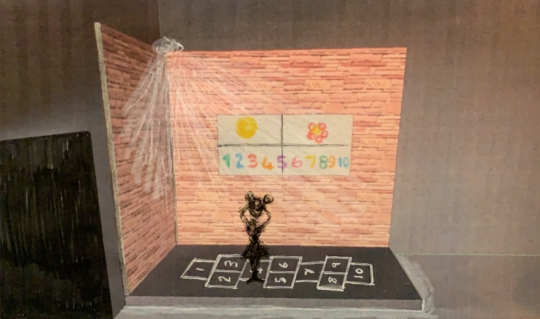

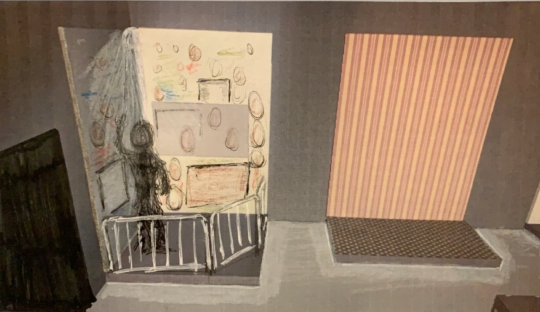

Cassie’s Design
SketchUp…
I used a combination of sketchup and hand drawing to create a 3d version of how I imagine the gallery space to look. I decided to add lighting underneath the stage areas to help guide the audience, as the exhibition would be quite dark. I also added black curtains to keep this experience separate from the rest of the museum. Information about the typewriter would be found on the wall outside the gallery to give it context and to inform the audience of its relevance and origin. I would also have a sign which informs the audience of potential themes that may pop up as well as include a warning about flashing/strobe lighting for those who suffer with epilepsy and other health conditions that may be affected. I don’t have a specific target audience because my topic overall, has no age limit. In other words everyone and anyone is affected. I would leave that responsibility to the parents of young children.I have included shots of a plan view, perspective view, and the 4 key moments from Amoy's’ life.
0 notes
Photo





Cassie’s Design
Storyboard for final concept...
( refer to previous post for the narrative)
These storyboards take us through the journey the audience will take through the experience.
0 notes
Photo





Cassie’s Design
Final Concept with MoodBoards….
For my final concept I decided to create a narrative based on the life of a fictional character that experiences racial hatred and discrimination throughout their entire life.
The final concept tells the story of ‘Amoy, a young black girl born to Jamaican parents, Trevor and Doreen. Amoy’s parents originally moved from Jamaica to the Uk (Birmingham) in the late 1960s as they strived for a better life, in the country whose roads were paved in gold. Doreen fell pregnant in September 1974 and would later give birth to little Amoy on April 26th1975.
Amoy was a happy child; her home life was filled with love, joy and laughter. Her parents worked hard and always tried their best to teach their daughter how to always do the right thing in life, even if she felt like the outcome wasn’t fair. They knew of the struggles that existed outside the comfort of their little haven and would spend time trying to prepare their little girl for what was yet to come. Amoy would only really experience the harsh realities of the world when she started school in 1981.
To show specific events in Amoy’s life I decided to split the gallery space into 6 areas; consisting of 5 stages and one visual post (area 6).
The main section (area 1) would host the Benjamin Zephaniah typewriter, which would type the narrative live with a supporting voiceover. Information about the typewriter and its origin would be located just outside the gallery to give it context so that the audience could read about it before they are welcomed in.
The audience would be invited to view 4 key moments in Amoy’s life that represent and ultimately steer the direction and choices she would later make. I decided to capture each moment through collage.
Collage for area 2
Playground setting - The innocence of a child – 1981 (Age 5)
Amoy attends a predominantly white school. Very few kids look like her.
The audience will gather round and view footage of conversations between children based on racial hatred. Examples of content “My mom said I can’t play with you because you don’t look like me”, “My daddy said that all colored people are monkeys”, “My grandad use to own your grandad” etc.……
The screen would then go blank and a projection of a school classroom would take its place. The stage area will light up and the audience will see a school playground setting with a figure of Amoy stood crying. Audio of kids playing and Amoy’s thoughts at that time would play (similar to monologue without the actor).
Collage for area 3
The Den – 1991 (Age 16)
It’s the end of the academic year and Amoy has finally left school with good grades. Her overall opinion of school isn’t great. She always tried her best and always submitted her work on time but unfortunately found that she was having to defend herself constantly as she was consistently singled out for petty reasons. Her teachers didn’t like her but she knew that in order to get through school, she had to keep her head down. This discrimination against her ultimately led to her meeting more kids like herself. They were labelled ‘The colored kids’ aka ‘The trouble makers. The Den is a place where Amoy and her friends would go and hang out when they wanted to forget about the harsh realities of the world. It was a place where they would go to chill and vent and just be themselves.
The audience will gather round and view footage of conversations between Amoy and her peers as they talk about their experiences in and outside of school. The screen will go blank and will be replaced with a projection of nature/trees, so that it looks as though they are in a secret den. The stage area will light up to reveal the inside of the den with a seated figure of Amoy. Audio of her thoughts in that moment will play.
Collage for area 4
The Stephen Laurence Inquiry Protests – 1998 (Age 23)
2 years after Amoy left school came the unfortunate death of teenager Stephen Lawrence in April 1993, who was murdered in a racially motivated attack, whilst waiting for a bus. The black community were absolutely outraged with how the police handled the situation. Amoy and her friends were equally disgusted and disturbed. At this point they are really fed up with the prejudices, discrimination and injustices of the world. They just wanted to be treated equally for once. They decide to travel to London to attend the protests as they seek justice for a fellow peer; and to ultimately see some positive change to police systems.
The audience will gather round to view footage from the protests. The screen will go blank and will be replaced with a projection of crowds from the protests. The stage area will light up and the audience will see a figure of Amoy protesting. Audio of her thoughts will play in that moment along with the sounds of busy crowds.
Collage for area 5
Case of mistaken identity – 2000 (Age 25)
Its 2 years since the protests, Amoy is out celebrating a friend’s birthday. An altercation breaks out between two females who are not associated with the celebrations, which escalates quickly. The police are called because a member of the public claims to have seen a weapon. Sirens are heard and a loud bang follows.
The audience gather round for the final scene. They view footage of Amoy and her friends celebrating and watch as the altercation between the two unknown females escalate. When the sirens are heard, the crowd of people disperse and that’s when the ‘bang is heard. The screen goes black, then the stage lights slowly come up to reveal a slumped figure of Amoy on the floor. Flashing emergency services lights illuminate the set. Audio of her thoughts and sad music will play as the life drains from her body.
I wanted to get the audience to experience the same emotions many families go through in the BAME community. Too many young lives are lost in unjust ways. Too many BAME lives are lost for unjust reasons. Real positive change can only happen when people wake up and unite. The fight isn’t for war … The fight is for Equality
United we stand,
Divided we fall.
0 notes
Photo
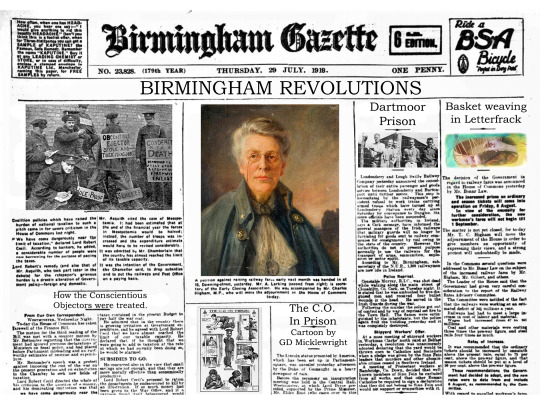
Rei’s Design
As not everyone has a smart phone or would want to engage with an exhibition in that way, I have also designed an information leaflet that is in the style of a 1918 Birmingham Gazette newspaper. It will contain the same information that can be found on the app and give further context to parts of Sophia Sturge and Lawrence Deller’s stories. This is also something that the audience can take away with them as a memento of the exhibition and can read later at home if they wish.
0 notes
Photo

Rei’s Design
As I don’t want any text in my exhibition space I needed to find a way to communicate the information to the audience in a clear and engaging way. I have designed an app that would be free for the audience to download and available on most smartphones. All of the images on the walls would have small QR codes next to them that you could scan on the app and it would bring you to a page that would tell you more information about that image/object. You could save your favourite images/stories for later, as well as share them to your social media. You could also use the app whilst not in the museum to look up whats on and find out information about exhibitions and pieces you’ve seen as the app would save all the QR codes you scanned so you can access the information later on. Allowing notifications would also let the app tell you when there are new exhibitions similar to your favourites.
0 notes
Photo



Rei’s Design - SketchUp
Using SketchUp I created a 3D representation of what I picture the space to look like, above are screenshots of an aerial view, as well as shots from the doorways. I feel this is an easy way to clearly communicate my concept and would like to spend more time familiarising myself with the software as there were some things that I would have like to include or make from scratch/improve upon but I am still quite a novice when it comes to this software.
0 notes
Photo
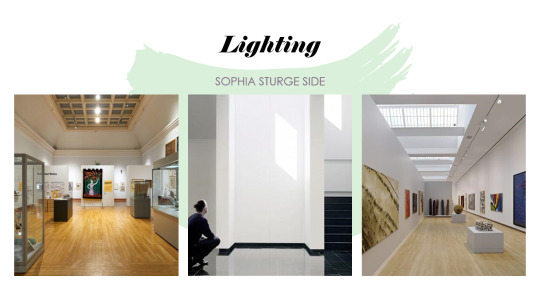
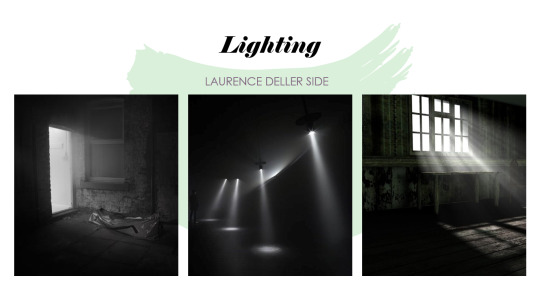
Rei’s Design - Lighting
On Sophia Sturge’s side I want to keep the light bright and natural, I want the colours on the wall to be vibrant and the whole space to really contrast Deller’s side and to use the natural skylight in the room to open up the space and bring in more natural light throughout the day. On Lawrence Deller’s I want it to be completely juxtaposed to the other side. To help the audience experience his time in Dartmoor Prison and put themselves in his shoes. I want to keep the space very dark with controlled very bright spotlights, I also want to make a false ceiling to cover the skylight inn the room and make the space smaller, making the viewer feel isolated and trapped.
0 notes
Photo

Rei’s Design
For Lawrence Deller’s Side I am designing the whole space to look like a prison courtyard. Above is a mock up of what a section may look like; concrete flooring with rocks and stones scattered around but creating a clear pathway, grey brick walls, and barbed wire where the walls meet a false ceiling. The purpose of the false ceiling is to make the space feel more enclosed and isolated, it will also help me control the lighting more accurately as there is a skylight in the room that during the day would let in too much natural light for this side. On the walls I want images of the C.O.s, the way they were treated, and their life at Dartmoor Prison. I want them to blend in naturally with the brick walls, all of these images are in black and white anyway so if the opacity of these images are lowered and edited onto the wall prints before they are made or if they are printed separately onto a clear film then they would hopefully blend in and look like they are carved directly into the stone.
0 notes
Photo

Rei’s Design
For Sophia Sturge’s side I want a vibrant mural that represents everywhere she went and what she accomplished; teaching the Irish town of Letterfrack basket weaving and how to make a sustainable business to help the community, she was president of the British Women’s Temperance Association that sought to educate people on the dangers of alcohol, drugs and gambling, she was a suffragette, a pacifist, and very anti-war, and in 1914 Sturge and other suffragettes and social reformers, across Britain, Germany, Austria and The Netherlands, assembled a Womens International Congress to try and reach a truce. Her life was so full of trying to help others and I feel every part of that story needs to be told but I don’t want to clutter the space with too much text and keep it very visual so covering the walls with just imagery lets every space be aesthetically intriguing. I have taken inspiration from the Mexican Muralism movement from the same era as the portrait that peaked in the 1920s, and specifically Diego Rivera who really became one of the most important figures of this movement.
0 notes
Photo

Rei’s Design
An aerial sketch of my exhibition layout concept.
I have started to plan out what my space might look like further. I am going to have Deller’s side in the style of the prison; brick walls, concrete floors with stones and barbed wire around the ceiling. Sophia Sturge’s side is going to be very contrasted to the other and have the lush grass of the field that surrounded the prison and a vibrant mural covering her walls, telling the stories of those she stood up and rebelled for.
0 notes
Photo



Rei’s Design
After a lesson on technology within exhibition design I had a further think about my concept and the phrase ‘bringing the painting to life’ stuck in my mind. I decided that it would bring another dimension to the design to have a screen in the middle of the room portraying a different looped video on each side. On one would be Sophia Sturge, posing as her portrait is being done, straightening her coat and keeping a clear but sensible smile, perhaps having a cup of tea from a flask out of sight. And in front of that screen would be a life sized model of Lawrence Deller, with his easel and paintbrush in hand. On the other side the screen would show a video of Lawrence Deller, Slightly obscured by his easel and canvas, but regularly peering round to get a clear view and holding up his paintbrush to measure the life sized model of Sophia that is display in front of the screen. both sides would also have bars around the screen, physical and cold to the touch, the pair are still divided though joined through their righteous cause.
0 notes
Photo

Rei’s Design
This is a mood board around my preliminary concept design. I feel that for the audience to feel connected to Sophia Sturge and Lawrence Deller they need to be in the room with them and so I have incorporated life sized models of the two into the space, with Sturge posing as Deller paints the portrait. I also felt that the prison bars were an important part of their story, Deller lost his life because of his time spent in Dartmoor prison and Sturge was ever present and ready to help those in need of someone to be their voice, advocating for the freedoms and rights of people from all walks of life. I felt that the fact Deller was put in to Dartmoor prison, subjected to hard labour and malnourishment that caused his death, was a poignant reminder of what we did to our own people during the atrocity of war. Deller was stuck between a rock and a hard place, being forced to choose between abandoning his beliefs and fighting a war he did not believe in or going to prison and dying a meaningless avoidable death, but holding on to his principles. The conscientious objectors were vilified in their time and often overlooked as casualties of war even now so I want this exhibition to bring this to the forefront and tell a story that is often forgotten.
0 notes
Text
Taxonomy of spatial function
When we think about the taxonomy of spatial function, we are basically focusing on the audiences’ experience of a space. Here we start thinking beyond the performance and instead focus on how we prepare the audience for what they are about to see. We take into consideration the audiences’ arrival, their actual experience of the exhibition/ performance and then their departure.
Gay McAuley, the author of ‘ Space in performance , divides the idea of space into 5 themes;
1. Social Reality – This refers to the building and all the parts that are needed to make it work. In terms of this project it would be the museum.
2. Physical/Fictional Relationship – This is the relationship between the actual stage space and the set created. For us this refers to the gallery space (13) and the set that we design and put in.
3.Location & Fiction - This refers to the actual set and the suggested /implied set. An example of this in theatre would be the interior of someone’s home/office/shed with a window etc and the implied would be the actor looking out of the window describing the scene. In exhibition design we create a location but imply that there is a further one.
4. Textual Space – This refers to the story, the text, the verbal information. In terms of the project it would be any written text, sound, audio visuals etc in an exhibition space.
5. Thematic Space – This refers to the meaning gained from the whole experience, from bringing all the above spaces together. As mentioned before this would be the audience’s journey throughout the whole experience.
With these things in mind we can start to think about the message that we want to be received and also keep them in mind, during the design process as we start to figure out ways of achieving and executing the aims we set ourselves.
2 notes
·
View notes
Text
Portrait of Sophia Sturge by Lawrence Deller

For my exhibition design concept I have chosen the portrait of Sophia Sturge (1918) by Lawrence Deller. I chose this painting as I found the duality of its two stories intriguing. There is the story of the subject, Sophia Sturge, an activist, abolitionist, suffragette, philanthropist, teacher and heroine. And the is the story of the unseen artist behind the piece, Lawrence Deller, a conscientious objector that was sent to Dartmoor Prison during WWI for standing up for his pacifist beliefs and who sadly lost his life because of the conditions C.O.s were put in. This painting separates them as well as links them and has so much to say.
0 notes
Photo

The Benjamin Zephaniah Typewriter
“Benjamin Zephaniah grew up in Handsworth and is one of Birminghams most successful and well loved writers. Inspired by the oral traditions of Caribbean culture, Zephaniah turned to poetry to speak out against racial hatred, The British legal and political system and poverty. This typewriter was given to Zephaniah in 1976. His first book ‘Pen Rhythm(1980) and second book ‘ The Dread Affair (1985) were both typed on this machine.”
(taken from card from Birmingham Revolutions Exhibition)
1 note
·
View note
Text
General Thought
The past few weeks have flown by and the project is nearing the end. In terms of documenting the journeys of the objects we have chosen, we decided that it would be better to provide links to our own individual blogs, thus not to disturb the fluidity of the posts on this main account, as we both are focusing on different objects. This also allows people to see the personal journeys we've both taken throughout the project.
Rei
Object - Portrait of Sophia Sturge by Lawrence Deller
Link - https://reiltinhart.tumblr.com/
Cassie
Object - The Benjamin Zephaniah Typewriter
Link - https://cassieceeart.tumblr.com
0 notes
Text
How Olafur Eliasson uses Semiotics and Scenography to create the experience of a setting sun.

What is Semiotics?
Semiotics is made up of a signifier and signified. The signifier can be reference to any physical object/occurrence that has a meaning. This could be in any form of visual stimulus I.e. drawn, painted, gestured etc. The signified is the meaning associated with or given to the signifier by the viewer. The meaning is not always fixed and can be up to interpretation.
What is scenography?
Scenography is the overall process of creating a place or atmosphere through the combination of technological and material elements. I.e. the combination of costume, lighting, set and object.
The Weather Project
Within his installation Olafur Eliasson uses light as his signifier and the audience interprets the signified to be the sun, something that is culturally universal. From this, the phenomenological experience of the audience member is feeling warmth from the "sun". Within the space there is also haze machines used to mimic real fog and replicate the natural atmospheric environment that occurs during a sunset and create that artificially within an indoor, man made environment.
The overall scenography of The Weather Project is successful in conveying a universal interpretation of the sun setting and the connotations that come with that.
0 notes